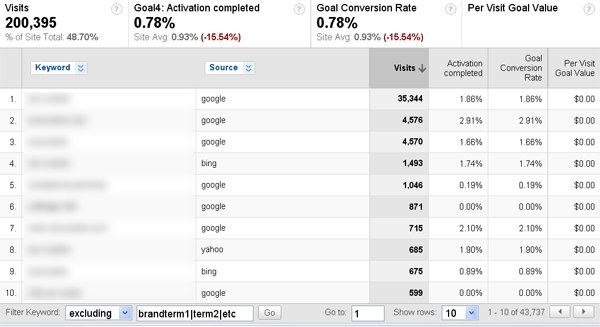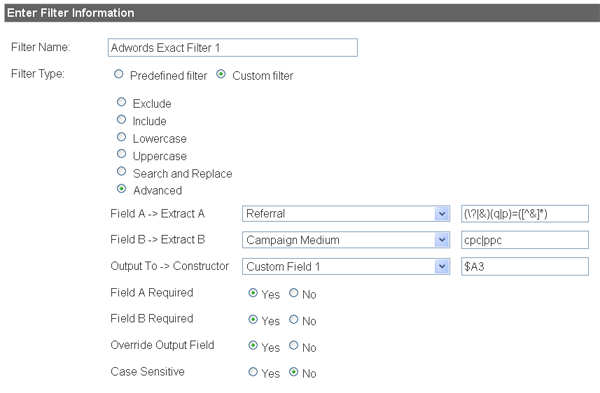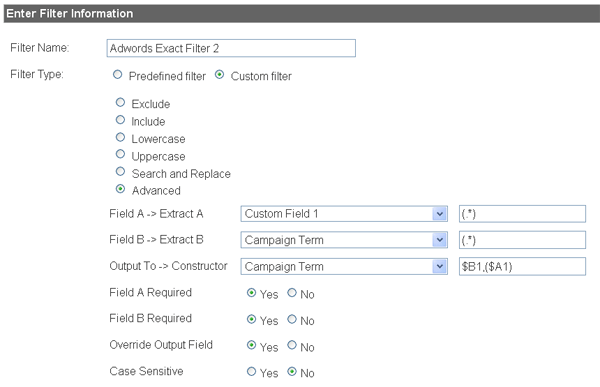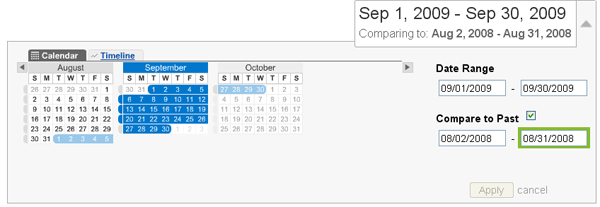 I consider the use of a solid modern analytics solution a basic necessity when running any type of search campaign, paid or otherwise, and require it of all the websites I work closely with. In the past it was much harder to gain actionable insight from these tools, but now I spend as much of my time helping people learn how to fish, as I do fishing for insights myself. My preferred tool, and what essentially enables this, is Google Analytics. I value ease of access to interesting and useful data, and how quickly novices can become familiar and productive with the tool. Google Analytics can be the lazy webmaster’s best friend (and I like to be lazy in bulk, it keeps me busy) without any tinkering, but can also be an extremely of an insightful tool for people who decide to go beyond looking at numbers, towards an interpretation of them, with a wee bit of config (and there is craziness beyond the basics, but let’s not go bonkers just yet).
I consider the use of a solid modern analytics solution a basic necessity when running any type of search campaign, paid or otherwise, and require it of all the websites I work closely with. In the past it was much harder to gain actionable insight from these tools, but now I spend as much of my time helping people learn how to fish, as I do fishing for insights myself. My preferred tool, and what essentially enables this, is Google Analytics. I value ease of access to interesting and useful data, and how quickly novices can become familiar and productive with the tool. Google Analytics can be the lazy webmaster’s best friend (and I like to be lazy in bulk, it keeps me busy) without any tinkering, but can also be an extremely of an insightful tool for people who decide to go beyond looking at numbers, towards an interpretation of them, with a wee bit of config (and there is craziness beyond the basics, but let’s not go bonkers just yet).
 A lot of what is presented in Google Analytics (okay lets get lazy and call it GA) is not quite as it seems, and without some work to dig into the data and interpret it, some default views might actually end up misleading your efforts. Getting the basics of Google Analytics down isn’t all that complex, but if you’re just starting out I do recommend getting a walk-through from someone who has used it from a marketing perspective in the past. If you’ve got e-commerce tracked there’s another aspect to consider, and even if you’re only concerned with a specific segment such as paid search, gaining some understanding of other sources of traffic is likely to help your paid efforts. I’m going to present a handful of ways to gain a little clarity, which is by no means a comprehensive overview of how to interpret your data (whole books are written, my friends, volumes), but it might help lessen some common misinterpretations.
A lot of what is presented in Google Analytics (okay lets get lazy and call it GA) is not quite as it seems, and without some work to dig into the data and interpret it, some default views might actually end up misleading your efforts. Getting the basics of Google Analytics down isn’t all that complex, but if you’re just starting out I do recommend getting a walk-through from someone who has used it from a marketing perspective in the past. If you’ve got e-commerce tracked there’s another aspect to consider, and even if you’re only concerned with a specific segment such as paid search, gaining some understanding of other sources of traffic is likely to help your paid efforts. I’m going to present a handful of ways to gain a little clarity, which is by no means a comprehensive overview of how to interpret your data (whole books are written, my friends, volumes), but it might help lessen some common misinterpretations.
1 – Clean Out the Brand & Expand
You need to mine your analytics software for keywords that can expand and contract your PPC account. The best source of lateral ideas for keywords to bid on, especially if you have a lot of content on your site, is from the organic traffic you already get from the search engines. In order to see the terms coming from search engines in GA, click Traffic Sources > Keywords. If you select “non-paid” you’ll see data over time for your organic traffic, and a short-list of your top referring keywords. You can choose another metric like source to see where they’re coming from, and look at goal or monetary information for them also. In order to clear this list up you have to apply an “exclude” filter on the list of keywords. This option is available at the bottom of the list of words, just pull down where it says “Filter Keyword” and select Exclude. In the exclude field type your brand words, or parts of words, separated by the pipe symbol, “|”. This symbol just means “or”. Once you apply the filter, the data over time graph at the top will reflect the filtered keywords, which incidentally is a great way to monitor your overall organic SEO efforts, as will the list of keywords presented. Simply set the number of rows in the bottom right to something large like “500”, and explore the list for juicy new keyword ideas.  So what happens if you don’t have organic traffic to mine keywords from? Mine your existing adwords traffic, which is tip 2.
So what happens if you don’t have organic traffic to mine keywords from? Mine your existing adwords traffic, which is tip 2.
2 — Exacting Adwords
If you’re running a PPC campaign, you need to understand your match types, and while I believe they should only be used very strategically, chances are you’re bidding on some broad-matched terms. The second technique I want to present for gaining clearer insight into your PPC campaign via Google Analytics is something I actually consider completely mandatory for any advertiser who utilizes “broad match” in their Adwords campaigns. It’s just a set of two filters that you apply in your GA account, which reveal to you the actual phrases that people searched at Google which triggered your ad. If you’re a PC computer shop and bid on broad-match for “laptops”, it might be nice to know if you wasted ten bucks today for people searching “apple laptops”. Revealing the long-tail of the phrases you’re bidding on lets you both expand and contract your account, intelligently. If you see phrases where the searcher-intent doesn’t match your website’s offering, look for patterns, and you might find a new “negative keyword” to prevent your ad from being shown where it’s not relevant. On top of contracting with negative matches, you should constantly mine this set of “long tail” phrases to find more phrases to bid on specifically. If you bid specifically on a phrase instead of on a part of it via broad-match, chances are you’ll be saving money, be up against less competition, and you’ll have a chance to tailor your ad and landing page with more relevance.  That funky string in filter 1 for you to copy/paste, so long as wordpress doesn’t muck it up: (?|&)(q|p)=([^&]*)
That funky string in filter 1 for you to copy/paste, so long as wordpress doesn’t muck it up: (?|&)(q|p)=([^&]*) 
3— Compare Data in Context
Google Analytics lets you look at data over time very easily, enabling you to spot trends, but if you don’t put the time-frames you’re looking at or comparing into context, it loses meaning. Sometimes a necessary aspect to consider in order not to lose context is seasonality. I recommend, in most cases, comparing time frames to their equivalent from the previous year — it rarely makes sense to compare Q1 data to Q4 data without taking seasonal trends into account, and if you don’t have a sophistimacated formula for doing so, just compare it to the same time last year. To do this just click the down arrow to the right of the date range box, and select “compare to past”. Then just change the secondary date range to read from a year earlier and click apply:  You’ll be rewarded with some contextual comparison data, and if you’ve gone to the trouble of filtering this chart down to relevant metrics ahead of time (such as non-branded organic traffic for SEO, or specific campaigns or keywords for PPC), you’ll have a nice distilled meaningful graph. Remember that seasonality is not the only way to gain context, always ask yourself if you’re comparing apples to apples or apples to oranges when you’re doing comparison work.
You’ll be rewarded with some contextual comparison data, and if you’ve gone to the trouble of filtering this chart down to relevant metrics ahead of time (such as non-branded organic traffic for SEO, or specific campaigns or keywords for PPC), you’ll have a nice distilled meaningful graph. Remember that seasonality is not the only way to gain context, always ask yourself if you’re comparing apples to apples or apples to oranges when you’re doing comparison work. 
There you have it folks, three simple but essential ways to gain a clearer view of your traffic and trends, to make more intelligent and informed decisions for your organic and PPC search campaigns.



